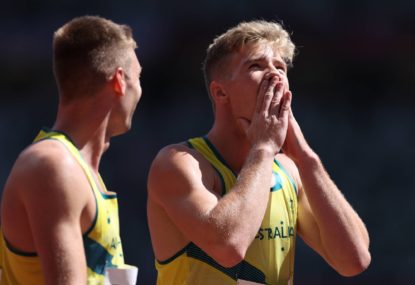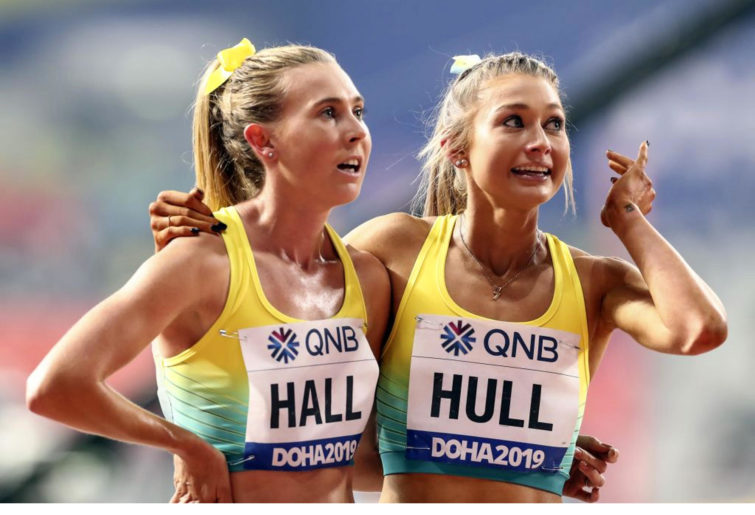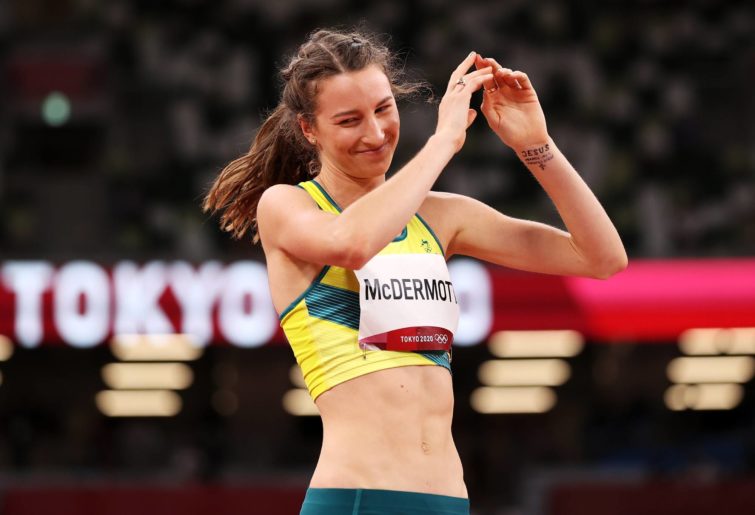'Punching above our weight': Who really won the Olympics?
Try to picture a town of only 46,832 people. According to Wikipedia, the closest real town to this in Australia is Gladstone (45,000), although…
Opinion

While I congratulate all of the Australian team who made it to the Tokyo given the coronavirus disaster, and am thankful the Olympic Games went ahead despite widespread Japanese public opposition, this article highlights the many Australian athletics competitors that did exceptionally well at Tokyo in terms of their results.
At face value in terms of medals won, Australia’s performance in athletics pales in comparison to other Olympic Games sports.
With just three medals (silver in the women’s high jump and bronze in the decathlon and women’s javelin), the lay person could note that Australia’s swimming teams alone won 21 medals (nine gold medals).
But the lay person should also note just how well Australia’s athletics team did in one of the toughest and most prestigious of all Olympic Games sports where most countries compete, despite that sport hosting the most Olympic Games events (48).
In the sprints, where Olympic Games stadiums normally produce pretty good conditions and the latest fast track technology, many of our sprinters did deliver with personal bests.
As the late Rick Mitchell (1980 Olympic Games 400 metres silver medalist) has stated, running PBs in the global competitions should indeed be the ultimate goal for our sprinters.
You simply cannot do better than that, as it is impossible to control the prospects of those competing against you as they run in their own individual lanes.
In the men’s 100 metres, Rohan Browning did fantastically to run a personal best of 10.01 in his heat to make the semi-finals.

(Photo by Matthias Hangst/Getty Images)
Browning, aided by a coach Andrew Murphy who knows all about the importance of leg power, will hopefully make further improvement in coming years in this extremely competitive event, which perhaps best expresses a human’s ability to demonstrate explosive speed.
Browning is already a very good technical runner who makes the most of his speed in terms of running an efficient 100 metres.
With the 100 metres being a glamorous event, which has the capacity to drive greater domestic interest in athletics, Browning could well become a leading light through his example for other young Australians to try and emulate.
Also very impressive was Riley Day, who ran a PB of 22.56 in the 200 metres when third in the semi-final.
Listening to Day being interviewed after the race, I was most impressed by her attitude when she thanked her coach and strength trainer while stressing her determination to do whatever it takes to succeed.
Day reminded me of a young Sally Pearson, who also expressed similar determination on ABC radio long before becoming a global hurdling star.
Our men’s 400 metres runners also did very well. Alex Beck ran a PB of 45.54 and Steve Solomon ran a PB of 44.94 in the first round before a gutsy third of 45.15 in the semi-final.
For those of us who have run the 400 metres at our own various standards, we know just how hard it is to back up with another maximal effort just days later after a near maximal effort.
While longer races of 800 metres and beyond are also decided by tactics, which makes the task of achieving PBs that much harder if races have a lack of pace, Australia did exceptionally well in a number of races.
In the men’s 800 metres, Peter Bol was simply outstanding with his fourth in the final where he demonstrated his mental toughness by giving himself every chance to medal.

(Photo by Michael Steele/Getty Images)
Bol also ran two Australian records on his way to the final, culminating in his semi-final win with 1:44.11.
Bol’s fourth place was Australia’s best result in Olympic Games men’s running events since Darren Clark finished fourth for the second time in the 1988 400 metres final.
The other two 800 metres runners also did very well to make the semi-finals with very good times with Charlie Hunter running 1:45.91 and Jeff Riseley 1:45.41.
In the 1500 metres, Australia’s athletes were outstanding with two males and two females making the 1500 metres final with all qualifying through top-five finishes in the semi-final. In the men’s race, Ollie Hoare and Stewart McSweyn became the first duo to make a 1500 metres final since 1956 when John Landy and Merv Lincoln ran third and 12th.
In the final, McSweyn ran seventh (3:31.91) and Hoare 11th (3:35.79), behind the brilliant Norwegian Jakob Ingebrigsten with an Olympic Games record (3:28.32).
In the women’s race, with Linden Hall and Jessica Hull qualifying for the final with the latter running an Australian record with 3:58.81 in the semi-final, this marked the first time that Australia has had two finalists in a Olympic Games 1500 metres female final.
In the final, Hall finished sixth with a PB 3:59.01 and Jessica Hull 11th with the latter perhaps jaded by her very fast run in the semi-finals.
Hall’s great run joins Margaret Crowley (fifth 1996) and Jenny Orr (eighth) as the only Australians to finish in the top eight in an Olympic Games 1500 metres final.

(Photo by Serhat Cagdas/Anadolu Agency via Getty Images)
In the short hurdle events, Liz Clay ran a PB in the semi-final with 12.71, while Nicholas Hough also made the semi-finals with 13.57 in the first round.
While Australia’s longer distance runners were less successful, they too had good results.
Patrick Tiernan, whose gutsy finish in an exhaustive state was evident for all Australians to see, did well just to qualify for the Olympic Games 10,000 metres final.
Genevieve Gregson, who also qualified for the 3000 metres steeplechase final after her good heat run, would hurt her achilles tendon when crashing at the last barrier and was unable to finish the race.
And Sinead Diver did extremely well to finish tenth of 88 starters in the women’s marathon, in a tough race where the very hot conditions resulted in 14 starters not finishing the race.
In the field events (four jumps and four throws events), Australia had record eight top-eight Olympic Games finishes, surpassing the previous high of six such places in 1984 and 2000.
In a fantastic female high jump competition, Nicola McDermott was brilliant leaping an outstanding 2.02 metres (Australian record) to win the silver medal, with Eleanor Patterson also doing very well to finish fifth with 1.96 metres.
McDermott’s narrow miss at 2.04 metres showed the world that she is far from finished in terms of achieving higher goals.
McDermott’s silver medal was Australia’s fifth ever Olympic Games high jump medal, thus making the high jump Australia’s most successful Olympic Games field event with five medals compared to four for the long jump.

(Photo by Getty Images)
In the men’s high jump, Brandon Starc leaped a SB of 2.35 metres to finish fifth, just two centimetres behind the gold medal height.
In the women’s long jump, Brooke Stratton finished seventh with her 6.83 metres final jump, her second top-eight finish at the Olympic Games after finishing seventh in 2016.
In the pole vault, Kurtis Marschall qualified for the final with 5.75 metres but unfortunately no heighted.
In the throws, while Australia’s women won their third ever Olympic Games throwing medal with a bronze in the javelin, it was great to see Matthew Denny achieve Australia’s best ever Olympic Games male throwing performance by finishing fourth with a PB of 67.02 metres.
Denny finished just five centimetres behind third and less than two metres from the winning distance of 68.90 to show that Australian males too can compete well at the highest global level in events that do require great technique and considerable strength.
In the javelin, Australia’s women uphold recent 2019 world championship success by achieving three of the top eight competitors, an unprecedented achievement by Australia in any field event.
The 2019 world champion Kelsey-Lee Barber won the Olympic Games bronze medal with a SB of 64.56 metres, Kathryn Mitchell finished sixth with 61.82 metres, and Mackenzie Little finished eight with 59.96 metres.

(Photo by Getty Images)
In this era with so many countries participating in every track and field event, it is simply stunning that Australia can achieved such a feat.
We have to go back to the 1950s to recall the only three times that Australia had three top-eight finishes in any event, that being the 1952 female 100 metres and the 1956 female 200 metres and 80 metres hurdles at a time when only six athletes qualified for sprint distance finals.
In the decathlon, track and field’s all-round test for males, Ashley Moloney was brilliant winning Australia’s first ever medal in that event with an Australian record of 8649.
Australia’s previous best decathlon result was sixth by Peter Mullins in 1948 behind the 17-year-old gold medal winner Bob Mathias who also won the 1952 Olympic Games.
Maloney joins Glynnis Nunn (the 1984 Olympic Games heptathlon gold medal winner) as the only Australians to medal in the two all-round events.
Moloney had many great performances in the ten events of the decathlon: 100 metres 10.34, long jump 7.64 metres, shot put 14.49 metres, high jump 2.11 metres, 400 metres 46.29, 110 metres hurdles 14.08, discus 44.38, pole vault 5.00 metres, javelin 57.12 metres and 1500 metres 4:39.19.
Quite simply, Maloney already has great speed to work with and only needs to improve his throws to become a gold medal chance in future global championships.
In the walks, Australia again did well in the Olympic Games with two top-eight finishes.
Rhydian Cowley finished eighth in the 50 kilometres walk, albeit robbed of seventh by the Chinese walker running past him in the last few metres, while Jemima Montag also finished sixth in the women’s 20 kilometres walk.
With Australia achieving 14 top-eight finishes in individual events (no relays), this was Australia’s third best ever Olympic Games result behind 23 such finishes in 1956 and 16 in 1968.
In running events with three top-eight finishes in individual races (800 metres and 1500 metres), this was the best result since 2000 when three of our women made the 200 metres and 400 metres finals.
In the men’s running events, the last time Australia had more than one runner finish top eight was 1988 when Darren Clark finished fourth in the 400 metres with Steve Moneghetti and Rob de Castella finished fifth and eighth in the marathon.
On the track itself, the last time Australia had more than one top-eight male finish was 1976 when Rick Mitchell finished fifth in the 400 metres and Graham Crouch eighth in the 1500 metres.
To again see Australian runners feature prominently on the world stage, along with running a few top-three places at several 2021 Diamond League meetings, is a great achievement.
To conclude, for a nation where athletics does not get much public attention outside an Olympic Games year, Australia continues to produce some very good athletes.
Despite only winning three medals, dwarfed by the 21 won by our swimmers, Australia’s performance in athletics at the 2021 Tokyo Olympic Games was one of our best ever in terms of top-eight finishes.
Given the 2021 Olympic Games results, it may well be that Australia is about to experience one of its best periods in terms of athletics performances for many years.
The good thing is that the 2022 World Championships in Oregon is not that far away.